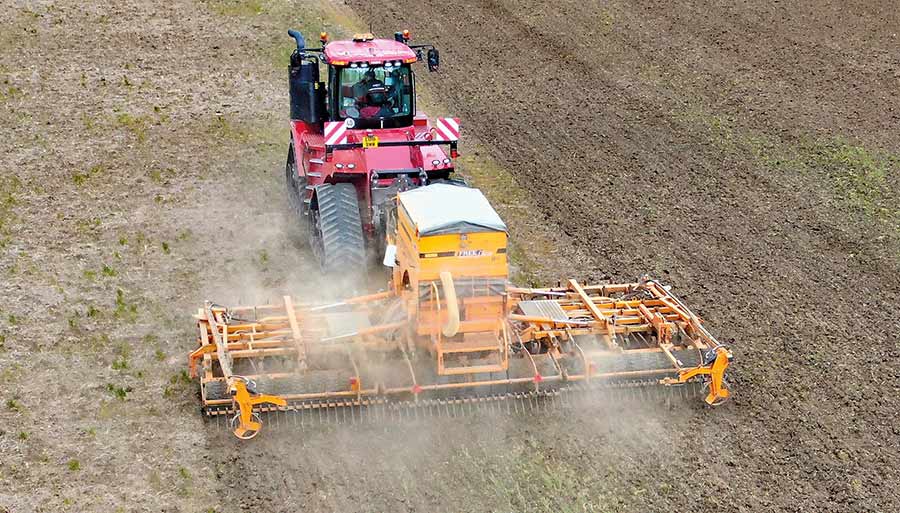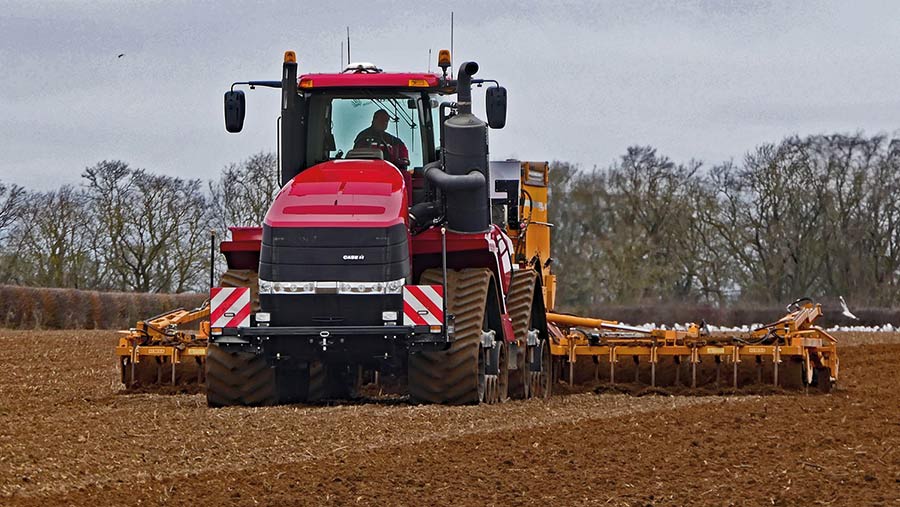What Lincs grower learned from spring barley drill demo
 © Andrew Ward
© Andrew Ward Successfully direct-drilling spring barley is a tough challenge on heavy soils and for one Lincolnshire grower, a min-till approach delivers the best returns.
However, work continues to find a viable approach for the spring cereal, as experts say increasing organic levels, strategic soil loosening and cover cropping can help offset some of the issues.
See also: Seaweed extract helps French grower cut costs and improve soils
Andrew Ward farms 650ha about 16 miles south of Lincoln, comprising light heath land along with heavier clay loam.
What makes the heavy soil at Glebe Farm such a challenge is the fact it has a combined silt and clay content of about 80%, albeit in varying degrees.
“More than 80% of our soil is made up of something difficult to deal with, and you can get slotting at drilling – with open slots and 50% or less germination.”
For the heavy land block, the family farm had historically used tracked machines employing a plough-based system.
It’s now 20 years since Mr Ward last ploughed a field and over the years, cultivations have progressively become less intensive.
In recent years a shallow disc cultivator has replaced a Simba Solo in some situations. A Simba Freeflow drill has been the one constant over the years.
Mr Ward is looking to see if he can cut establishment costs further, which is especially important given the higher diesel prices.

© Andrew Ward
In a bid to see if cultivations could be reduced by purchasing a specialist direct drill, he hosted an Agrii demo day last year.
A total of 10 drills were put to work and farmers came along to see for themselves how the machines coped.
Crop establishment was monitored by Agrii, and Mr Ward recorded yields at harvest.
The results show his existing system delivered the highest yield and gross margin (see “Yields and margins”), although Mr Ward points out that conditions weren’t ideal for direct drilling on the day.
Agrii trials manager Steve Corbett explains that the ground was not set up for direct drilling and conditions were marginal for fieldwork.
It was further compounded by a midday shower, but because it was a demonstration day with visiting farmers, they had no option but to continue.
The Freeflow plot yielded 6.8t/ha and generated a gross margin of £1,405/ha.
The next best was the Claydon at £1,151/ha, closely followed by a clutch of other drills, including the Amazone Cayenna, Sky EasyDrill and the Horsch Avatar.
Separate to the trial in an ongoing 9ha direct drill and cover crop trial, Mr Ward compared his existing system with spring barley drilled with a Horsch Sprinter following a cover crop.
The Sprinter delivered a gross margin of £1,164/ha, compared with the farm standard at £1,714/ha, a difference of £550/ha.
For the time being, Mr Ward can’t justify losing the 2t/ha in spring barley yield that is incurred with a cover crop.
“It doesn’t stack up. Even if we do get Sustainable Farming Incentive money for cover cropping, it’s not viable losing more than £500/ha.”
Mr Ward points out that cover crops also have a cost, along with the slug pellets that are needed on heavy land.
Therefore, yields actually need to be higher than in the existing system.
Establishment
Delving deeper into the results, Mr Corbett showed that establishment ranged from 40% to 60%. The use of a straw rake did bring some to more than 60%, but still not near the 70-80% needed.
He says the problem was that soil wasn’t friable in the rooting zone, although it was well structured underneath.
That’s why the tine-based cultivators had higher yields, as they helped with tilth in the conditions. The narrower the opener, the greater the risk of creating a slot.
Mr Ward also believes some of the difference was down to tine-based drills mixing soil and incorporating the nitrogen.
Liquid nitrogen was applied with the glyphosate and it sat on the surface, so direct-drilled plants didn’t pick it up until it rained.
“It was dry for some weeks before picking up nitrogen. So on the day, a bit of soil movement made a big difference,” he says.
The future
Looking to the future, Mr Corbett believes cover crops have a place, but it’s a long journey on these soils.
“The silt/clay combination makes it challenging, as silt moves between clay blocks,” he explains. “Cover crops have a role in holding the silt and stop it moving between the clay particles.”
However, getting good cover crop establishment is proving elusive on this soil. In eight years of trials, only four have been reasonable, says Mr Corbett.
Mr Ward highlights the narrow window for establishing cover crops with spring barley.
A double spring barley crop gives the best level of blackgrass control, but you can’t drill too early on these soils, so you can’t harvest early.
Typically, spring barley is harvested in early September, so time is running out to establish cover crops well.
Agrii’s trials are ongoing and this season saw one of the best cover crops, which will be direct-drilled with barley this spring.
Drill change leads to drop in fuel use
Last October saw the arrival of a John Deere 8RX, which replaced a Quadtrac 620, downsizing from 620hp to 410hp.
This has dropped the weight by 9t and Andrew Ward is now using 50% less fuel with the 8m Freeflow.
“We were averaging 17 litres/hr with the Quadtrac and it’s now 7.5-9 litres/hr on the drill.”
It’s similar for the Solo, falling from 30-34 litres/hr to 17-21 litres/hr, while giving good performance. “It pulls the Solo quite well.”
Yields and margins |
||||
|
Drill |
Yield (t/ha adjusted to 15% moisture) |
Total cost (£/ha) |
Crop value (£/ha) |
Gross margin (£/ha) |
|
Simba Freeflow |
6.80 |
488.07 |
1,816 |
1,405 |
|
6m Weaving Sabre |
5.65 |
411.08 |
1,480 |
1,069 |
|
6m Amazone Cayenna |
5.86 |
411.08 |
1,559 |
1,148 |
|
6m Dale Ecodrill |
5.49 |
411.08 |
1,438 |
1,027 |
|
6m Claydon |
5.85 |
411.08 |
1,562 |
1,151 |
|
3m Sumo DTS |
4.76 |
411.08 |
1,247 |
836 |
|
6m Horsch Avatar |
5.78 |
411.08 |
1,543 |
1,132 |
|
6m Horizon DSX |
5.56 |
411.08 |
1,479 |
1,068 |
|
6m Sky EasyDrill |
5.78 |
411.08 |
1,543 |
1,132 |
|
3m Simtech T-Sem |
4.32 |
411.08 |
1,132 |
721 |
|
Cover crop then Horsh Sprinter |
6.38 |
507.17 |
1,672 |
1,164 |
|
Solo then Freeflow |
8.25 |
489.17 |
2,203 |
1,714 |
|
Note: Simtech T-Sem is more suited for green material drilling; two narrower drills (Sumo plus Simtech) saw lower yields as greater proportion of area is wheeled |
||||

